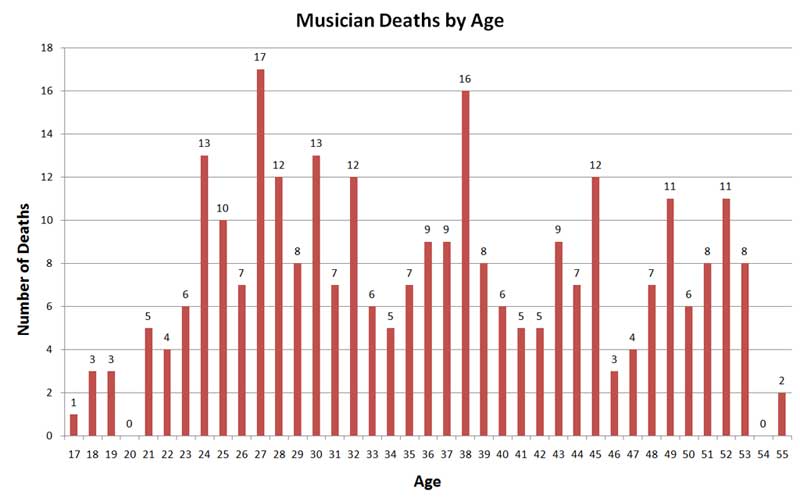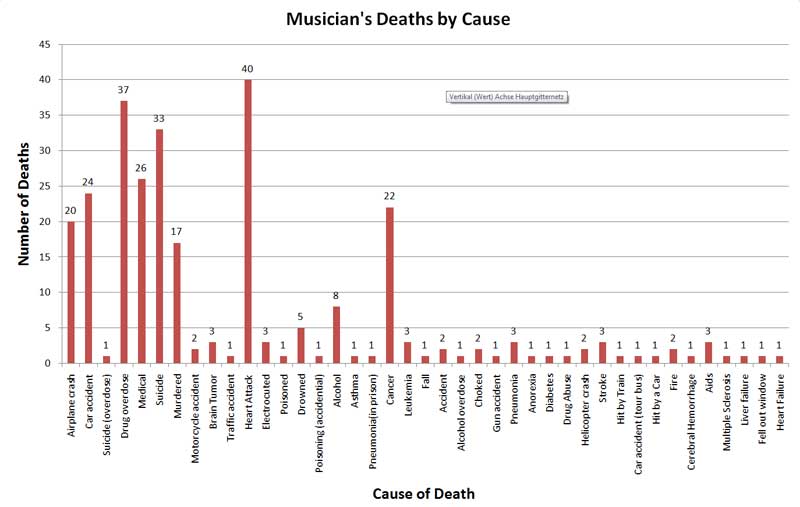The 27 Club
The death of Amy Winehouse has caused the inboxes of all skeptical podcasters to burst at the seams with discussion of “the 27 club”, an urban legend stating that an unusually high number of pop stars has died at that ominous age. Such notables as Jimi Hendrix, Janis Joplin, Kurt Cobain, and Jim Morrison have welcomed Amy Winehouse to that great recording studio in the sky, all having died at 27.
The 27 Club legend predated Amy Winehouse, so when she died and some journalist first noted her age, the media did as we’d expect and made a big deal out of it (here and here, for example). There are web sites about the 27s (like this and this) and at least one book and one movie on the subject. And so, the skeptical mind tends to wonder: (1) do an unusually large number of musicians die at 27; and (2) is there some reason why this is so that defies explanation?
Such was one topic of discussion this week on Skeptalk, and one poster, Andre, did a bit of digging. The idea was to graph out the deaths of musicians and look for anything unusual. The data source was this web site, which appears to be a religious site warning of the evils of rock music, stating that rock stars die at an average age of 36.9, while Americans at large die at 75.8. I’m not sure how many of the rock stars listed are Americans, but we don’t really care about that. Obviously this is not a perfect data source, but it’s good enough for an afternoon mailing list lark. Here’s what Andre came up with:
So far as I notice, nobody bothered to calculate the standard deviation and all, but there don’t seem to be any real surprises. The distribution looks random enough to me. Perhaps the biggest surprise is that we don’t also have urban legends about a 38 Club. Harry Chapin, Sam Kinison, Brent Mydland of the Dead, and Johnny Thunder all died at 38. Perhaps not the biggest names, but almost exactly as large a spike in the data.
It seems unlikely that any argument that death mysteriously calls for the biggest talents at age 27 is likely to be convincing. Most of the really famous musician deaths — Elvis Presley, Michael Jackson, Buddy Holly, Richie Valens, Keith Moon, Bob Marley, et. al., — were not invited to the 27 Club.
For ghoulish grins, Andre also graphed out the causes of death for this same group:
An interesting analysis would be to cross reference the two, and see which causes of death strike musicians of a given age compared to the population at large. Without having looked into it myself, I’d expect the stereotypical causes (drug overdoses, suicide) to strike musicians more often, and probably at younger ages when they’re not yet accustomed to the pressures of life as a rock star. For this reason, I think it’s probable that we’d find musicians are more likely to die in their twenties than the population at large. Michael Jackson is an exception who really illustrates how hard it must be for a top star to make it through their early years; very few people lived under as much pressure as he did from such a young age and through the rest of his life. It’s little wonder that he turned out the way he did.
The 27 Club? I can’t say the distribution looks anything other than random. But statistical accuracy is not the reason we want such urban legends to be true. Sometimes we derive just a little too much macabre excitement from watching trains crash.




I would suggest deadoraliveinfo.com would be a far better resource for such information, than the christian website which has an agenda.
Such statistics are massively skewed towards those who died young, because they do not count those who have not died yet. And data on the dates of the deaths of those who have not died will not be available until they die, which could take a while.
There could be a bit of a cult of musicians who believe in the curse getting a bit carried away at that age because they believe in the curse. Janis Joplin has been reported to have mentioned it often, but I don’t have a way of confirming this. So it oculd be likely that those like Cobain and Winehouse who died of overdoses or suicide tried to avoid committing suicide until they got to that age and their legend status oould be assured.
Interesting thoughts. I’m glad you posted about this.
However, I’ve never really heard anyone, while talking about the 27 Club, claim that more musicians in general die at that age, or anything like that. I think it’s just a specific fascination with the cluster of Joplin, Morrison, Hendrix, and Brian Jones who all died at 27 due to drugs between July 69 and July 71. Even Kurt Cobain is typically not included in the 27 club from this perspective. It’s really an isolated cluster of those 4. So, while your analysis is well taken, I don’t think anyone has ever really argued what you refute… except maybe in the media after Winehouse died. I didn’t really see anything about it in the news so I wouldn’t know.
I wonder what (a) the graph looks like for the population of the USA, and (b) what the graph looks like for habitual compulsive users of alcohol and other drugs which can kill directly (so no marijuana-only folks since people don’t seem to die from an O.D. on that).
The reason that one cannot overdose on marijuana is that eventually one can no longer lift the bong to one’s lips; presumably because one forgets where one’s mouth is.
Interesting that the most common age at death for musicians really is 27.
“The distribution looks random enough to me.”
Yeah, that’s not good. For the population at large, the distribution increases exponentially with age before dropping off.
http://www.data360.org/dsg.aspx?Data_Set_Group_Id=587
I’d like to see this same analysis done with better source data. The religious source is clearly biased against musicians that live longer.
The religious website’s list is called “Premature Death of Rock Stars,” which implies that it only includes premature deaths, say before age 56. Still, you’d normally expect more deaths in the 45-55 range than in the 25-35 range.
Also, their list only goes up to April 2001, so it doesn’t include more recent deaths like George Harrison (aged 58).
Bear in mind that rock and roll is fairly young, and rock musicians usually started young, so many like Bob Dylan and Mick Jagger are still alive.
Wikipedia has a more dynamic list.
http://en.wikipedia.org/wiki/List_of_deaths_in_rock_and_roll
There doesn’t seem to be any good way to develop a proper data set. How would you define a musician or even a ‘rock star’? Any list is going to be extremely arbitrary. There are people who make a good living as session musicians who are anonymous to most of us. How could they be included in any list?
How about Roland the Roadie and his kin?
Yeah,the whole thing stinks of cherry picking and confirmation bias.
There are, most likely, some very good reasons why a “rock star” (call it anyone who achieves rapid success and wealth) might encounter an early demise vs the average person: Increased travel raises the chances of accidental death.Wealth increases access to copious amounts of drugs.The realization of success is often not what it is cracked up to be,and carries with it many negatives that can cause depression and disillusionment leading to suicidal tendencies that are either directly acted on,or lead to self destructive behavior. There are probably others,but you get the point.
A quick dump of the Wikipedia list into Excel does show age 27 with the highest frequency for this data set: 19 / 94 with the other most frequent ages in the 12 – 15 / 94 range. It looks a little bi-modal around the thirties and sixties too. Excellent fodder for pattern seeking and speculation on the impact of the R&R lifestyle.
The argument on the religious web site (rock related deaths compared to non-rock deaths) is completely fallacious since it cherry picks young tragic deaths and includes no data on the general population to make the comparison it’s claiming to. Plus, it’s religious. Brian’s charts seem fine. Mostly because he’s not making any claims about the total population of musicians or the total population in general. It’s just a list of deaths of musicians, grouped by cause and age. Though, he did forget to include “knocked off by devotees of Charlie Manson and made to look like a drowning”.
From a career development standpoint, I’d love to see some research on the timeline musicians pass through. Since most everything will be rooted in anecdotal evidence and teen pop stars will ruin everything, wouldn’t it be neat if there was enough to say, “here is the average time a band spends ‘in the trenches,’ here is how long their star rises, here is where they plateau, and this is-on average-when they fizzle/crash and burn/hit rock bottom/retire/start working in casinos or cruise ships or county fairs.”
Well now I’ve gone and depressed myself.
Sometimes you just have to chalk things up to coincidence, and lighten up.
Well, it’s kind of inevitable, if you think about it. Nobody’s going to become a professional rocker until about age 18. Assume it takes about 5 years to “pay your dues” and get successful, that puts you at 23. At that point you make a splash, the dough starts rolling in. Spend a year getting drunk or high, then a year in rehab, get hooked on harder stuff and it’s two years to an overdose. Basically, if you’re predisposed to substance abuse, 27 is about when you’ll have the opportunity to die of your addiction if you’re a rock star. Presumably other fields skew older because it takes more time to get successful enough to indulge yourself to death.
27 a golden number.
Your comment got a mention on the ‘Skeptics With A K’ podcast #052 Trimegistus.
Who cares?
Who cares?
Who cares?
I said it three times because one time was too short for the interface.
I rarely use “LOL” unless I’m joking but you’ve earned a genuine LOL on that comment. I agree with you 100%. I left the publishing/production industry for this very reason alone. Celebs. Who cares.
Once people invent something like the 27 club (by observing one pattern of many, and then talking it up), ongoing entry into it is often self-selecting (in this case, via drug overdose or more obvious suicide methods). There is a psychological pull among a small, self-selecting group of musicians to want to be mythologized by association with this “club”, and perhaps some of them go so far as to join it deliberately. This is not conjecture — I’ve heard various musician friends discuss their own or their musician friends’ desires to be a part of this myth by dying at the appropriate age. Every now and then, someone actually does it (consciously or not, and of course sometimes truly by accident), and the myth perpetuates.
I would hope that most of the readers on this site know how silly this is.
Quite clearly none of the members of The 27 Club will be going to heaven. Which says a lot about the elevator music on the way up there.
One of the names in the 38 Club needs correction – it was Johnny Thunders (ex-New York Doll) who died at 38. Johnny Thunder (of one-hit “Here We Go Loop De Loop” fame) is still alive and kicking.
Thanks as ever for a great blog!
Another weird tidbit was the inclusion of the non-musical comedian Sam Kinison. By the way, Bobcat Goldthwait, who is often confused with Kinison, is alive and well and directing films (despite setting fire to Jay Leno’s Tonight Show set).
Brian, the real mystery is your preference for the letter T. Of the 27 sentences in this blog posting, 7 (26%) begin with T. Could this show a preference for the Tea Party? Or perhaps an irrational bias against coffee? Then if we take 1 instance each of the letters you began your sentences with, they can be anagrammed into “Mob Faith Swap,” which clearly reveals your evil plan. Of course, those letters also spell “Fatwas Bop Him,” so clearly justice is on its way.
Club or co-incidence, I’m not sure…I have written and produced a song called “27” about this. My band is The Cheek of Her, please feel free to listen and download from the website http://www.thecheeekofher.com
They said she’s gotta go to rehab, and she said, “No, no, no.” Maybe she should have gone!
There still seems to be a connection with rock musicians who have acheived super stardom but can’t really handle it. Add thoses stresses to the stress of approaching 30, and it makes sense that 27 would be a dangerous age for people in that position. I always thought that if Lennon hadn’t been with the Beatles to give him support, he might have joined the 27 Club.
At any rate, i also found it strange you used statistics from a clearly biased source, which i think did not help your case. Which is not to say you are not right, just that a more careful examination of the facts is needed to say one way or the other.
One interesting point this article omits to mention is that the “27 Club” myth is often said to originate with the legendary blues musician Robert Johnson. Amongst other things, he was allegedly a lousy guitarist who suddenly became an incredibly good one as a result of summoning the Devil by standing at a crossroads at midnight holding a black cat’s bone (it’s easier than you thought!).
It is claimed that his playing on the recordings he later made appears to involve more than 10 fingers, and that he always played with his back to the audience to hide his Satanically endowed magic extra finger. He is also credited with being directly responsible for the invention of rock and roll. He died in 1938 at the age of – naturally! – 27, apparently from drinking whiskey laced with strychnine by a man whose girlfriend he stole.
So really the myth may derive from the granddaddy of the whole thing dying at that age, according to some people because his contract with Satan had expired. Thus the expectation was already in place, and it only took one rocker to also die at 27 for certain people to say “Aha!”
Similarly, it’s very doubtful if the “Curse of King Tut” would have taken root in popular culture if the elderly and not especially healthy Lord Carnarvon hadn’t died a few weeks after the tomb was opened, thus priming a certain type of person to watch out for any remotely unusual deaths among the numerous people who unearthed the tomb, even if they happened many years later, and the great majority of those involved eventually died in ways that weren’t unusual at all.
But Amy Winehouse was not an artist.